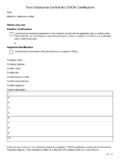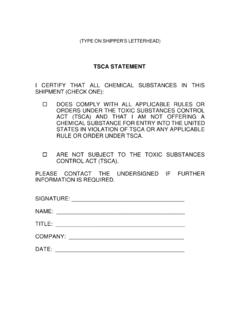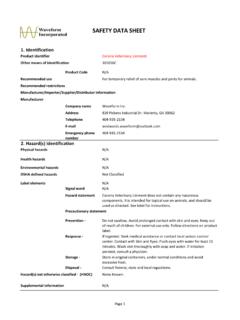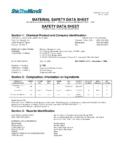Transcription of 2018PROCESSOR INVENTORY NOTIFICATION …
1 2018 PROCESSOR INVENTORY NOTIFICATION ACTIVE-INACTIVE REQUIREMENTSTRUE OR FALSE?REPORTING TIMELINERESOURCESWHAT IS TSCA?ADDITIONAL INFORMATIONWHAT IS A PROCESSOR?ABOUT IAEGRETROSPECTIVE REPORTING LEGAL DISCLAIMERWHY SHOULD I REPORT?RISKS OF NON- COMPLIANCEWHAT TO DO NEXT? NOTIFICATION DEADLINEP rocessor Reporting October 5, 2018 TSCA | 3 The toxic Substances control Act (TSCA) Chemical substance INVENTORY identifies chemical substances manufactured, processed, or imported in the United States for uses that the Environmental Protection Agency (USEPA) regulates ( , other than food, drugs, cosmetics, pesticides)WHAT IS THE PURPOSEOF THIS REGULATION?EPA is required by Section 8(b) of TSCA to compile and keep the INVENTORY currentThe INVENTORY was initially published in 1979 and now lists about 85,000 chemicalsTSCA INVENTORY NOTIFICATION (Active-Inactive) requires manufacturers, importers and processors to update the INVENTORY by identifying the chemical substances active in commerceThe submission period for manufacturers and importers ended on February 7, 2018 REPORTING SEQUENCE TIMELINETSCA | 4 Aug 11, 2017 Feb 7, 2018 April 12, 2018 Oct 5, 2018 Dec 4, 2018 (approx.)
2 Mar 4, 2019(approx.)COMPLETEDUPCOMING MILESTONESF inal Rule is PublishedDeadline for Manufacturers / Importers to NotifyEPA published updated TSCA INVENTORY of ACTIVE chemical substancesEPA will publish FINAL InventorySubstances will become InactiveDEADLINE FOR PROCESSORS TO NOTIFY GRACE PERIOD TSCA | 5 Any person who prepares or repackages a chemical substance , prior to distribution in commerce ( 55 gallon drum of lubricant repackaged and sold to 3rd parties in smaller containers)Any person who processes chemicals, as part of a mixture or article for distribution in commerce ( mixing of a two-part epoxy for application on aircraft parts)PROCESSING EXCLUDES:Simply purchasing chemical substances with no intent to distribute into commerce ( , floor cleaning solutions)TSCA defines processor as any person that prepares a chemical substance after its manufacture for distribution in commerce (either in the same or different form or physical state) or as part of an article containing the chemical substanceWHAT IS A PROCESSOR?
3 TSCA INVENTORY NOTIFICATION REQUIREMENTS APPLY REGARDLESS OF BUSINESS SIZE, CHEMICAL VOLUME AND INDUSTRY SECTORRETROSPECTIVE REPORTING Companies must identify chemical substances that were manufactured, imported or processed from June 21, 2006 through June 21, 2016 (Lookback Period)WHEN:October 5, 2018 WHAT:TSCA | 6 WHO:Companies that processed a chemical substance during the Lookback PeriodReview the SDS (Safety Data Sheets) provided by the manufacturers or formulators, or other resources with product information. Note that the SDS may not contain the complete INVENTORY of chemicals in that mixture. You may need to go back to your supplier to obtain the additional information (eg. CAS#) or a statement of TSCA your processor list to EPA s latest publications including the updated TSCA INVENTORY and the most recent list of NOA Form A chemical : Companies that manufactured or imported a chemical substance during the Lookback PeriodWHEN: February 7, 2018 WHAT: Must have notified EPA via CDX* (EPA s Central Data Exchange) of chemical substances that are manufactured or importedNOTE: A company that imports a formulated mixture imports all the individual components of that | 7 WHY SHOULD PROCESSORS REPORT?
4 Although processors are not required to submit retrospective notice of activity reports before the October 5, 2018 deadline, EPA has provided a mechanism for voluntary NOTIFICATION of inactive chemical substances. This helps companiesWHY SHOULD COMPANIES CARE?AVOID BUSINESS DISRUPTION If your company has a subsidiary that meets the definition of a processor, it is required to comply with environmental regulations, including the TSCA INVENTORY NotificationViolation of TSCA could result in significant financial penalties as well as manufacturing, importing and/or processing delays WORTH THE RISK?If processors discover they are using inactive chemical substances after EPA publishes the Final INVENTORY (and beyond the 90 day grace period), they must cease processing until they submit required paperwork to EPA Violations of TSCA pose a potential business and legal risk to processors, and business disruption risk to their customersTSCA | 8 CRIMINAL PENALTIES: Up to one year in jail / $50,000 penalty per day or both, for knowing or willful violationsCIVIL PENALTIES: Up to $37,500 per violation per dayXWHAT TO DO NEXTI dentify the chemical substances in all formulations processed to produce products for distribution in commerce during the Lookback Period (June 21-2006 - June 21-2016).
5 Review TSCA regulations for reporting requirements and potential to October 5, 2018, continuously validate your company s list of chemical substances against EPA s latest publications, including the updated TSCA INVENTORY and the most recent list of NOA Forms. This is necessary to ensure the chemicals processed during the Lookback Period are designated as you processed a chemical substance during the Lookback Period and the chemical has not yet been activated, submit the NOA Form A by October 5, 2018 (a CDX account is required for submission).ALLOW SUFFICIENTTIME FOR SUBMITTALAPPROVAL1234 TSCA | 9 TSCA | 10 Use the resources below to submit your form(s)Central Data Exchange (CDX) Electronic Reporting PortalChemical Information Submission System (CISS) Reporting TooleNOA Software ModuleNOTICE OF ACTIVITY FORM A RETRO-SPECTIVEREPORTINGSTEP 1 STEP 2 STEP 3 TRUEFALSEOR Is there a mechanism for processors to report chemicals processed after the Lookback Period (eg.)
6 2017)? TRUEEPA recognized that the current reporting system with the set Lookback Period of June 21, 2006 through June 21, 2016, does not allow for reporting of chemicals processed after June 22, 2016 using NOA Form A, and set up a mechanism to address this issue. At the end of the processor reporting period, EPA will provide a 90-day window that will delay chemicals being formally designated as inactive. This 90-day window will allow a company that processed a chemical after the Lookback Period that has not otherwise been notified to submit a NOA Form B, which will move the notified chemical to the active list. TSCA reporting should not be a concern for my company because as a processor, this is optional. FALSE While reporting for processors is optional, it is an important mechanism that allows processing companies to ensure all chemicals of commercial interest are appropriately designated as active.
7 If processors do not ensure that substances are listed as active at the end of the reporting period, their process operations will be considered non-compliant and subject to TSCA enforcement and associated penalties. TSCA | 11 Isn t TSCA INVENTORY NOTIFICATION reporting the chemical manufacturer s or importer s responsibility? TRUEThis is correct. However, the reporting option for processors allows processing companies to ensure all chemicals of commercial interest are appropriately designated as active, as a means of ensuring business continuity for your company and detailed information on the TSCA NOTIFICATION Rule including requirements and definitions, please refer to the following links and tools Final TSCA INVENTORY NOTIFICATION Rulemaking TSCA INVENTORY NOTIFICATION Rulemaking User Guide CDX Registration User Guide IAEG Overview Document: TSCA INVENTORY NOTIFICATION Rulemaking Bergeson & Campbell Guidance Materials: TSCA INVENTORY NOTIFICATION RulemakingRESOURCES AND TOOLS FOR YOUThe below tool is used to complete the registration process.
8 Go to EPA s website to prepare and submit your registration in the Central Data Exchange | 12 TSCA Hotline1-202-554-1404 TSCA Email Website GestautasBoard Chairwas founded in 2011 with a vision to advance innovative environmental solutions for the aerospace and defence industry. Starting with 11 Founding members, now at 50 members, this collaboration forum is designed to address pertinent environmental issues that all member companies face. As we have grown, we have found tremendous value and synergy in working these non-proprietary issues together, for the betterment of the industry at large.$400 BILLION OUT OF AN APPROXIMATE $700 BILLION INDUSTRIAL BASE*SLIGHTLY OVER 1 MILLIONCOMPLEX AND INNOVATIVE PRODUCTS THAT LAST DECADESIN THE MARKETPLACE*Deloitte, 2014 Global aerospace and defense sector financial reportUSEUOTHERREVENUE FOOTPRINTEMPLOYMENT FOOTPRINTSOLUTIONSOUT OF A ROUGHLY 2 MILLION INDUSTRIAL BASE* TSCA | 13 THIS DOCUMENT IS PROVIDED BY THE INTERNATIONAL AEROSPACE ENVIRONMENTAL GROUP (IAEG) FOR INFORMATIONAL PURPOSES ONLY.
9 DETERMINATION OF WHETHER AND/OR HOW TO USE ALL OR ANY PORTION OF THIS DOCUMENT IS TO BE MADE IN YOUR SOLE AND ABSOLUTE DISCRETION. NO PART OF THIS DOCUMENT CONSTITUTES LEGAL ADVICE. USE OF THIS DOCUMENT IS VOLUNTARY. IAEG DOES NOT MAKE ANY REPRESENTATIONS OR WARRANTIES WITH RESPECT TO THIS DOCUMENT OR ITS CONTENTS. IAEG HEREBY DISCLAIMS ALL WARRANTIES OF ANY NATURE, EXPRESS, IMPLIED OR OTHERWISE, OR ARISING FROM TRADE OR CUSTOM, INCLUDING, WITHOUT LIMITATION, ANY IMPLIED WARRANTIES OF MERCHANTABILITY, NONINFRINGEMENT, QUALITY, TITLE, FITNESS FOR A PARTICULAR PURPOSE, COMPLETENESS OR ACCURACY. TO THE FULLEST EXTENT PERMITTED BY APPLICABLE LAWS, IAEG SHALL NOT BE LIABLE FOR ANY LOSSES, EXPENSES OR DAMAGES OF ANY NATURE, INCLUDING, WITHOUT LIMITATION, SPECIAL, INCIDENTAL, PUNITIVE, DIRECT, INDIRECT OR CONSEQUENTIAL DAMAGES OR LOST INCOME OR PROFITS, RESULTING FROM OR ARISING OUT OF A COMPANY S OR INDIVIDUAL S USE OF THIS DOCUMENT, WHETHER ARISING IN TORT, CONTRACT, STATUTE, OR OTHERWISE, EVEN IF ADVISED OF THE POSSIBILITY OF SUCH DAMAGES.
10 2018 International Aerospace Environmental Group . All rights | 14






